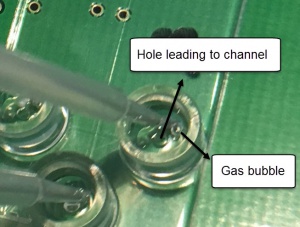Procedure for Microchip Electrophoresis with C4D with the ET121
Positioning of the High Voltage Electrodes
Applying a high voltage to a solution can cause the formation of gas bubbles at the electrodes. This can prevent the flow of electrical current. It can also result in an electric arc which produces high temperatures and can damage the chip. You should avoid positioning the high voltage electrodes inside the hole at the very bottom of reservoir, that leads to the chip's channel. The formation of a gas bubble inside this hold could prevent the flow of current.
Chip Preparation
Unlike glass microfluidic chips, plastic chips don’t normally require to be preconditioned before use. Researchers using plastic chips such as PMMA poly(methylmethacrylate) have reported they simply flushed the chip's channel with deionized water and then background electrolyte for a few minutes each. At the end of a working day, the microchips were rinsed with deionized water in order to prevent clogging of the channels.
